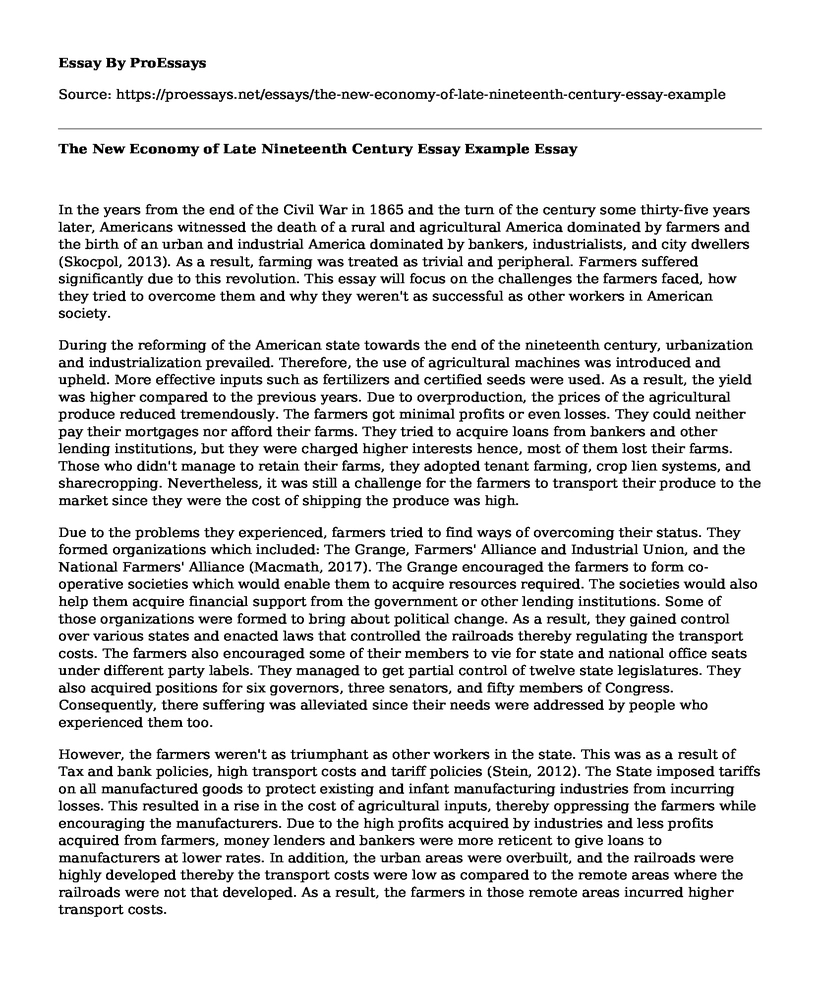In the years from the end of the Civil War in 1865 and the turn of the century some thirty-five years later, Americans witnessed the death of a rural and agricultural America dominated by farmers and the birth of an urban and industrial America dominated by bankers, industrialists, and city dwellers (Skocpol, 2013). As a result, farming was treated as trivial and peripheral. Farmers suffered significantly due to this revolution. This essay will focus on the challenges the farmers faced, how they tried to overcome them and why they weren't as successful as other workers in American society.
During the reforming of the American state towards the end of the nineteenth century, urbanization and industrialization prevailed. Therefore, the use of agricultural machines was introduced and upheld. More effective inputs such as fertilizers and certified seeds were used. As a result, the yield was higher compared to the previous years. Due to overproduction, the prices of the agricultural produce reduced tremendously. The farmers got minimal profits or even losses. They could neither pay their mortgages nor afford their farms. They tried to acquire loans from bankers and other lending institutions, but they were charged higher interests hence, most of them lost their farms. Those who didn't manage to retain their farms, they adopted tenant farming, crop lien systems, and sharecropping. Nevertheless, it was still a challenge for the farmers to transport their produce to the market since they were the cost of shipping the produce was high.
Due to the problems they experienced, farmers tried to find ways of overcoming their status. They formed organizations which included: The Grange, Farmers' Alliance and Industrial Union, and the National Farmers' Alliance (Macmath, 2017). The Grange encouraged the farmers to form co-operative societies which would enable them to acquire resources required. The societies would also help them acquire financial support from the government or other lending institutions. Some of those organizations were formed to bring about political change. As a result, they gained control over various states and enacted laws that controlled the railroads thereby regulating the transport costs. The farmers also encouraged some of their members to vie for state and national office seats under different party labels. They managed to get partial control of twelve state legislatures. They also acquired positions for six governors, three senators, and fifty members of Congress. Consequently, there suffering was alleviated since their needs were addressed by people who experienced them too.
However, the farmers weren't as triumphant as other workers in the state. This was as a result of Tax and bank policies, high transport costs and tariff policies (Stein, 2012). The State imposed tariffs on all manufactured goods to protect existing and infant manufacturing industries from incurring losses. This resulted in a rise in the cost of agricultural inputs, thereby oppressing the farmers while encouraging the manufacturers. Due to the high profits acquired by industries and less profits acquired from farmers, money lenders and bankers were more reticent to give loans to manufacturers at lower rates. In addition, the urban areas were overbuilt, and the railroads were highly developed thereby the transport costs were low as compared to the remote areas where the railroads were not that developed. As a result, the farmers in those remote areas incurred higher transport costs.
Conclusion
Reforming the American society encouraged urbanization and industrialization making the state richer and more powerful. However, the population of the society that depended on agriculture as its core source of income experienced more harm than good. As a result, most of the farmers moved to the urban centers in search of an alternative source of income consequently congesting the built-up areas.
References
McMath Jr, R. C. (2017). Populist Vanguard: A History of the Southern Farmers' Alliance. UNC Press Books.
Skocpol, T. (2013). Diminished democracy: From membership to management in American civic life (Vol. 8). University of Oklahoma press.
Stein, J. C. (2012). Monetary policy as financial stability regulation. The Quarterly Journal of Economics, 127(1), 57-95.
Cite this page
The New Economy of Late Nineteenth Century Essay Example. (2022, Nov 06). Retrieved from https://proessays.net/essays/the-new-economy-of-late-nineteenth-century-essay-example
If you are the original author of this essay and no longer wish to have it published on the ProEssays website, please click below to request its removal:
- American History Book Curriculum
- How Different From Each Other Were the Antebellum North and South?
- Compare and Contrast Essay on Julius Caesar and Abraham Lincoln
- Essay Example on Vivid Tones and Sacrifice in Helmet for My Pillow
- Paper Example on Drivers of Demand for Spotify Subscriptions
- Research Paper on Israel: A Land of Ancient History and Jewish Identity
- Essay Example on Exploring Political Science Trends Post WW2: UN Mission for Unity







